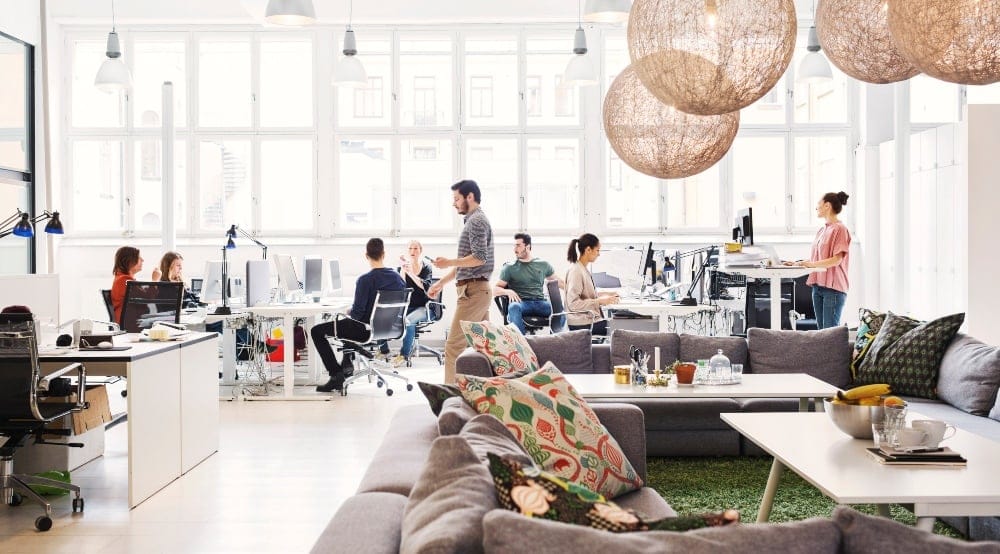
Let us help you with finding an office space
Our experts are here to help take the hard work out of finding your next office space.

A happy workforce is also a highly productive one. But businesses can only truly get there when leaders tap into all possible avenues to give employee job satisfaction a boost. Aside from offering competitive salaries - and a decent amount of annual leave - there are a few low-hanging opportunities that can help with this too.
One of these is having the correct lighting in the office. This sets the tone for higher productivity levels, while also suggesting that the wellbeing of the team is a priority. If you’re looking to upgrade your work environment this year — potentially with one of our flexible office spaces — we’ve got five transformative office lighting ideas right here to make the final decision a simple one.
Moving to a new office creates a fresh opportunity to explore different types of lighting for the space. Deciding what to go with should factor in cost, energy consumption and total output to start.
You should also choose a type that benefits the efficiency of the team. The three most commonly found modern office lighting options are incandescent, (compact) fluorescent and light-emitting diode:
Incandescent bulbs are slightly more old-school and typically a fixture of older buildings. From an output perspective, unlike their counterparts, they reach their maximum output levels very quickly.
They also burn at higher temperatures, have relatively short lifespans and tend to consume more energy. In a sustainability-driven world, this should be factored into your planning. You may want to use these bulbs as decorative or accent lighting, to be used rarely, rather than in the primary fixtures around the office.
In spite of their high energy consumption, incandescent bulbs do get at least one thumbs-up in terms of eco-friendliness. They are made using a non-hazardous metal, which makes them easy to dispose of when they need to be replaced.
Fluorescent bulbs pack a punch and last longer than their incandescent counterparts. Typically sold in tube form, they are easy to install, making them a versatile option to consider. They also burn at cooler temperatures, while still offering a decent lumen output.
That said, because they use mercury, they can be a health hazard in the event of breakage. It also makes them more difficult to dispose of in an environmentally-friendly way.
Compact fluorescent light (CFL) bulbs, therefore, are an energy-efficient “upgrade”. These are sold in more types than just tubes, conveniently slotting into the same traditional fittings as incandescent bulbs.
In a setting with white walls, fluorescent lighting tends to create a slightly clinical atmosphere. Softening the space with greenery, colourful furniture and decorative furnishings to fill the space is essential to reduce glare and subsequent eye strain. Doing so will boost employee productivity and may well lead to fewer complaints to HR, too.
The last of the “big three” options to consider in your new office space is light-emitting diodes (LED) bulbs. These dependable, long lifespan, energy-efficient bulbs offer consistent output quality. They also operate at cool temperatures, so are less likely to overheat and shatter.
In spite of their ability for high lumen outputs, thanks to the power of technology, LED bulbs run at low wattage levels. The downside is that they are more expensive than their counterparts, meaning you’ll have to invest a little bit upfront in order to place them across the entire office space.
The good news is that you won’t have to replace these too often, and they’ll reduce the amount of strain on your eyes in the office. As well as this, they come in a variety of shapes and sizes, giving you the freedom to design a practical lighting setup, while sticking to the decor theme.

Once you’ve decided on the best bulb type(s) for the team, it’s time to decide where these should be positioned, based on the office layout. Always start with the areas that feature the most natural sunlight first.
From there, think about the placements that will enhance this natural light. Correct placement primarily involves taking the actual light fixtures into account but also extends to the desks and other furniture in the space too.
An easy tell that lighting has been correctly positioned is that it goes unnoticed by anyone entering the space. The team should feel calm and relaxed when they start their workday, preferably without having to squint or cover their eyes when they move from one room to the next.
Try to localise your light source as much as possible across the entire office. Consider the function of the lighting before you decide on the final position. Talk to us about this when you’re first exploring a new office space, as we can offer a bit of tried-and-tested advice. It can’t hurt to get input from the team as well, to understand their needs, too.
If finding a new office space also means bringing in new furniture, you should think about clever furniture placement in order to maximise the natural light in any room. In terms of the actual pieces, choose lighter colours and shiny surfaces to amplify this even more.
Where you put the furniture matters a whole lot, too. Play around with a few options in the various spaces to find what works best for you and your business needs. Where possible, you should angle all workspaces towards sunlight. Set out with the intention to create ambient desk lighting wherever possible, in order to avoid day-to-day disruptions as the sun moves.
Having a maintenance plan in place for checking, dusting and replacing office lights — ideally coordinated by an office manager — encourages a fruitful work environment. Well-kept lighting fixtures are generally less likely to cause work disruptions brought on by problematic bulbs.
If a hybrid work model is a feature of your business, the same level of maintenance consideration should be given to employees working from home every now and then. Making sure that they also have correct, working lighting in place takes the entire team into consideration, rather than just those in the actual office.
Start a conversation with your employees about their lighting needs for the odd day spent working remotely. Find out whether they need an extra desk lamp, replacement bulbs to match the types used in the physical office, or even just advice on maximising their exposure to natural light. The extra consideration will boost job satisfaction levels, which go hand-in-hand with increased productivity.

Smart technology has already begun transforming homes and office spaces around the world. Investing in smart lighting is a great way to boost productivity levels by catering to the individual needs of members from different teams of departments.
Ever evolving, smart lighting currently introduces the following to the work environment:
Now you know how important it is to set up your office with the right lighting, the idea of planning it out might seem daunting. But you don’t need to do it alone. Investing a serviced office space means that all the hard work is done for you - whether that’s choosing the right lighting, desks, chairs and furnishings. The lighting in these more flexible office spaces is typically recessed in the ceiling, or hangs down for a more laid back aesthetic and feel.
Meetings rooms in flexible office spaces will typically offer a range of lighting options, so you can choose the office space that fits in most with what atmosphere and feel you want for your business.
While you can’t change the lighting in the main office, you can add to it to make it feel more like your own space. Table lamps, neon light signs and standing lighting options can quickly shift the mood, depending on the areas you’re working in and the aesthetic you’re after. However, it’s important to note that any adjustments of the space and lighting will need to be discussed with the office manager.
There’s no need for you to go on the search for a new office space alone. We’re here to help find the best possible options for you and your team, whether you’re looking for a traditional, serviced or managed office space.
Our listings go above and beyond by including all the lighting and amenities you need to increase productivity and continue to run a successful business. We offer access to a range of practical options based on the needs of your workforce. A quick consultation with us will be able to give you practical advice, in order to make the process as effortless as possible.
Increasing productivity levels in the office is a real possibility when you implement the lighting ideas we’ve mentioned here today. By thinking about in-office and remote workers at the same time, the entire team can work at full capacity.
The key to getting there is to take decisive action, along with making room in your yearly planning to address all the ways to improve job satisfaction — and upgrading the office is a great place to start.
From there, new opportunities for innovation will start to prevent themselves.
Get your monthly dose of workplace insights, productivity hacks and business leadership ideas - delivered straight to your inbox.

Our experts are here to help take the hard work out of finding your next office space.